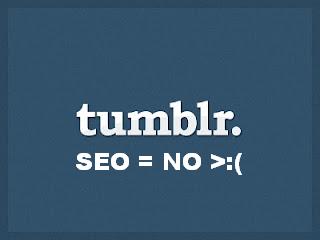Out of the box, Tumblr is a great way to quickly get a blog up and running. It’s slick user interface means you can get content live in a snazzy format within seconds, without having to invest in web development wizardry. I love it for that.
But it’s a serious mistake to consider is part of an SEO strategy.
I’ve started classroom fights with fellow nerds and been given after-school detention for this opinion. As always, there is a lot of bad advice in the search universe on how to hack-and-slash the Tumblr platform to improve it’s borked SEO abilities.
Granted, it does have a few SEO tricks, but it’s not enough.
Will your posts get indexed? Yes, will they rank for pointless terms that nobody searches for? Probably.
Tumblr = Simplicity (Not SEO Friendly)
You see, Tumblr is designed to be a simple blogging platform by nature and as a result – a Tumblr blog sadly misses a lot of key details to really make an impact on search engine visibility.
I’ll admit it, I launched this Blog on Tumblr to get things started (what it’s good at) – but boy, did I regret it. Let’s have a look why.
6 Reasons why Tumblr SUCKS for SEO
- Tumblr will strip out any attempt to put the rel=”nofollow” attribute on links, free links anyone? #SEOFacepalm
- You can’t set custom META Tags on each individual post, I know this isn’t 1998 SEO, but META descriptions are a great way to improve clickthrough-rates. You can hack the theme to auto-generate META based on your post summary/tags but that’s just sloppy.
- No Category Structure – You can’t set a category structure to Posts or URLs (e.g. /recipes/italian/meatballs/) dampening the chance of gaining mid-tail rankings or building up authority to a ‘parent’ page
- Forget about gaining Google Images rankings – all image uploads in Tumblr will be stored on a separate sub-domain, with no reference to your Blog’s URL
- All Tumblr blogs come with XML Sitemaps & Robots.txt files which is great – but there is no way to customise them.
- Messy HTML & CSS code – Tumblr has some awesome custom themes, but lack of FTP access to your blog means all CSS, Javascript etc. has to be either coded within the page, or hosted externally – both of which will hurt a blogs load time
In time, Tumblr hopefully will do right upon these wrongs, but in the meantime, just use WordPress. It does everything, including making your morning cup of tea.
